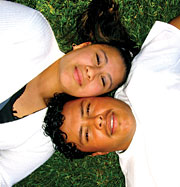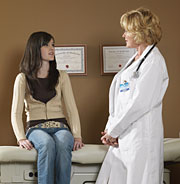What is Diabetes?
Learn about diabetes and how to manage it.
What is diabetes?
 Diabetes means that your blood glucose (GLOO-kos), also called blood sugar, is too high. Glucose comes from the food you eat and is needed to fuel our bodies. Glucose is also stored in our liver and muscles. Your blood always has some glucose in it because your body needs glucose for energy. But having too much glucose in your blood is not healthy.
Diabetes means that your blood glucose (GLOO-kos), also called blood sugar, is too high. Glucose comes from the food you eat and is needed to fuel our bodies. Glucose is also stored in our liver and muscles. Your blood always has some glucose in it because your body needs glucose for energy. But having too much glucose in your blood is not healthy.
An organ called the pancreas (PAN-kree-as) makes insulin (IN-suh-lin). Insulin helps glucose get from your blood into your cells. Cells take the glucose and turn it into energy.
If you have diabetes, the pancreas makes little or no insulin or your cells cannot use insulin very well. Glucose builds up in your blood and cannot get into your cells. If your blood glucose stays too high, it can damage many parts of the body such as the heart, eyes, kidneys, and nerves.
Are there different types of diabetes?
 Yes. There are three main types of diabetes.
Yes. There are three main types of diabetes.
In type 1 diabetes, the cells in the pancreas that make insulin are destroyed. If you have type 1 diabetes, you need to get insulin from shots or a pump everyday. Most teens can learn to adjust the amount of insulin they take according to their physical activity and eating patterns. This makes it easier to manage your diabetes when you have a busy schedule. Type 1 used to be called “insulin dependent” or “juvenile” diabetes.
In type 2 diabetes, the pancreas still makes some insulin but cells cannot use it very well. If you have type 2 diabetes, you may need to take insulin or pills to help your body’s supply of insulin work better. Type 2 used to be called “adult onset diabetes.” Now more teens are getting type 2, especially if they are overweight.
Gestational (jes-TAY-shon-al) diabetes is a type of diabetes that occurs when women are pregnant. Having it raises their risk for getting diabetes, mostly type 2, for the rest of their lives. It also raises their child’s risk for being overweight and for getting type 2 diabetes.
Why do teens get diabetes?
 Both genes and things like viruses and toxins may cause a person to get type 1 diabetes. Studies are being done to identify the causes of type 1 diabetes and to stop the process that destroys the pancreas. Researchers can now predict who is at risk for developing type 1 diabetes and in the future may be able to prevent or delay the onset of the disease.
Both genes and things like viruses and toxins may cause a person to get type 1 diabetes. Studies are being done to identify the causes of type 1 diabetes and to stop the process that destroys the pancreas. Researchers can now predict who is at risk for developing type 1 diabetes and in the future may be able to prevent or delay the onset of the disease.
Being overweight increases the risk for type 2 diabetes. Teens who make unhealthy food choices, are not physically active, or who have a family member with diabetes are more likely to get type 2 diabetes. Some racial groups have a greater chance of getting diabetes—American Indians, Alaska Natives, African Americans, Hispanics/Latinos, Asian Americans, and Pacific Islanders. It is not true that eating too much sugar causes diabetes.
What do I need to do to take care of my diabetes?
 The key to taking care of your diabetes is to keep your blood glucose as close to normal as possible. The best way to do this is to:
The key to taking care of your diabetes is to keep your blood glucose as close to normal as possible. The best way to do this is to:
- make healthy food choices
- eat the right amounts of food
- be active everyday
- stay at a healthy weight
- take your medicines and check your blood glucose as planned with your health care team
Your doctor will tell you what blood glucose level is right for you. Your goal is to keep your blood glucose as close to this level as you can. Your doctor or diabetes educator will teach you how to check your blood glucose with a glucose meter.
It helps to know what affects your blood glucose level. Food, illness, and stress raise your blood glucose. Insulin or pills and being physically active lower your blood glucose. Talk with your doctor or diabetes educator about how these things change your blood glucose levels and how you can make changes in your diabetes plan.
Carbohydrates (CAR-boh-HY-drates), or carbs for short, are a good source of energy for our bodies.But if you eat too many carbs at one time, your blood glucose can get too high. Many foods contain carbs. Great carb choices include whole grain foods, nonfat or low-fat milk, and fresh fruits and vegetables. Eat more of them rather than white bread, whole milk, sweetened fruit drinks, regular soda, potato chips, sweets, and desserts.
Why do I need to take care of my diabetes?
If you take care of your diabetes you can lower your risk for other health problems. High blood glucose can harm blood vessels and cause heart attacks or strokes. It can also damage organs in the body and cause blindness, kidney failure, loss of toes or feet, gum problems, or loss of teeth.
The good news is that when you take care of your diabetes, you can reduce or avoid these problems.
Do not let diabetes stop you! You can do all the things your friends do and live a long and healthy life.
Publications
Tips for Teens with Diabetes: Make Healthy Food Choices
(NDEP-66)
These tip sheets provide useful information about diabetes and encourage teens to take action to manage their disease for a long and healthy life.
Tips for Teens with Diabetes: Dealing With the Ups and Downs of Diabetes
(NDEP-81)
These tip sheets provide useful information about diabetes and encourage teens to take action to manage their disease for a long and healthy life.
*Application Required
PDF files require the free Adobe Acrobat Reader application for viewing.
WMV is Video file in Windows Media Player format. Download the free Windows Media Player application for viewing.
All our publications are copyright-free. Please duplicate and distribute as many copies of these materials as desired.
Attention visually impaired visitors: To use common screen reading programs with PDF documents, please visit access.adobe.com, which provides a set of free tools that convert PDF documents to simple HTML or ASCII text.





